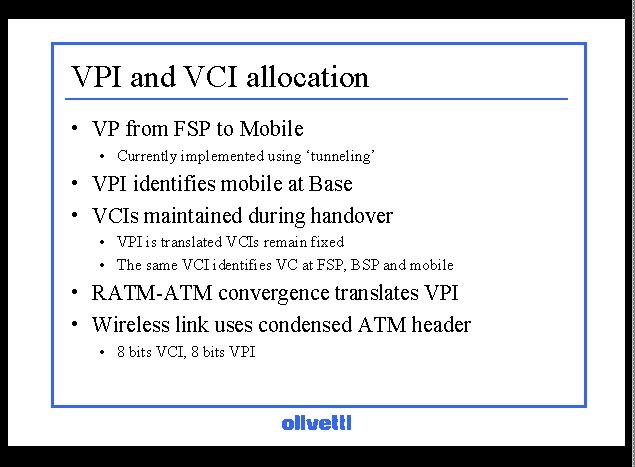 |

|

|

|

|
 |

|

|

|

|
VPI and VCI issues.
Virtual path established from FSP to mobile via a base station.
The link between the FSP and base is currently implemented using a tunneling protocol. We do not have virtual paths in the system and it is not clear that the UNI ATM header has sufficient bits to support the desired number of mobiles within the ATM mesh.
The tunneling involves using the ATM end-points of the FSP and base when signaling between the FSP and the Base. The original end-points of the signaling request are then restored when the signaling request reaches the ends of the tunnel. The tunnel is implemented by sending a tunneling establishment message down the handover-signaling message, which contains the true end-point identifiers of the connection.
The ATM network needs only to route the connection based on either the FSP or Base addresses so the ATM routing protocol can remain static.
At the base-station the mobile is identifed by its VPI. This is used at a number of levels. First it allows the various signaling protocols to operate on PVCs within the allocated VPI. Only the VPI needs to be established by the meta-signalling protocol.
The VPI is also a useful short identifier which can be used by other protocol layers to index information relating to the mobile. This is particularly useful at the MAC.
During handover between base-stations the active virtual circuits continue to use the same VCIs and only the VPI is changed. The same VCI identifies a connection at FSP, BSP and the mobile. This makes re-connection of the virtual circuits within the ATM network trivial during handover.
The translation between mobile VPI and the VPI assumed by the higher ATM protocol layers is hidden by the RATM-ATM convergence layer.
The wireless link uses a condensed ATM header with 8 bits of VCI and 8 bits of VPI. The number of VPI bits determines the maximum number of mobiles which can be registered at a particular base-station. Because mobiles use different base-stations the 8 bits of VCI can all be used by a single mobile. Clearly these numbers are fairly arbitrary the number of VCI bits is fairly unimportant, 8 seems enough for the ATM applications which we are familiar with. Changing the number of VPI bits makes more of a difference as it is used to provide indexing in the MAC layer etc.....